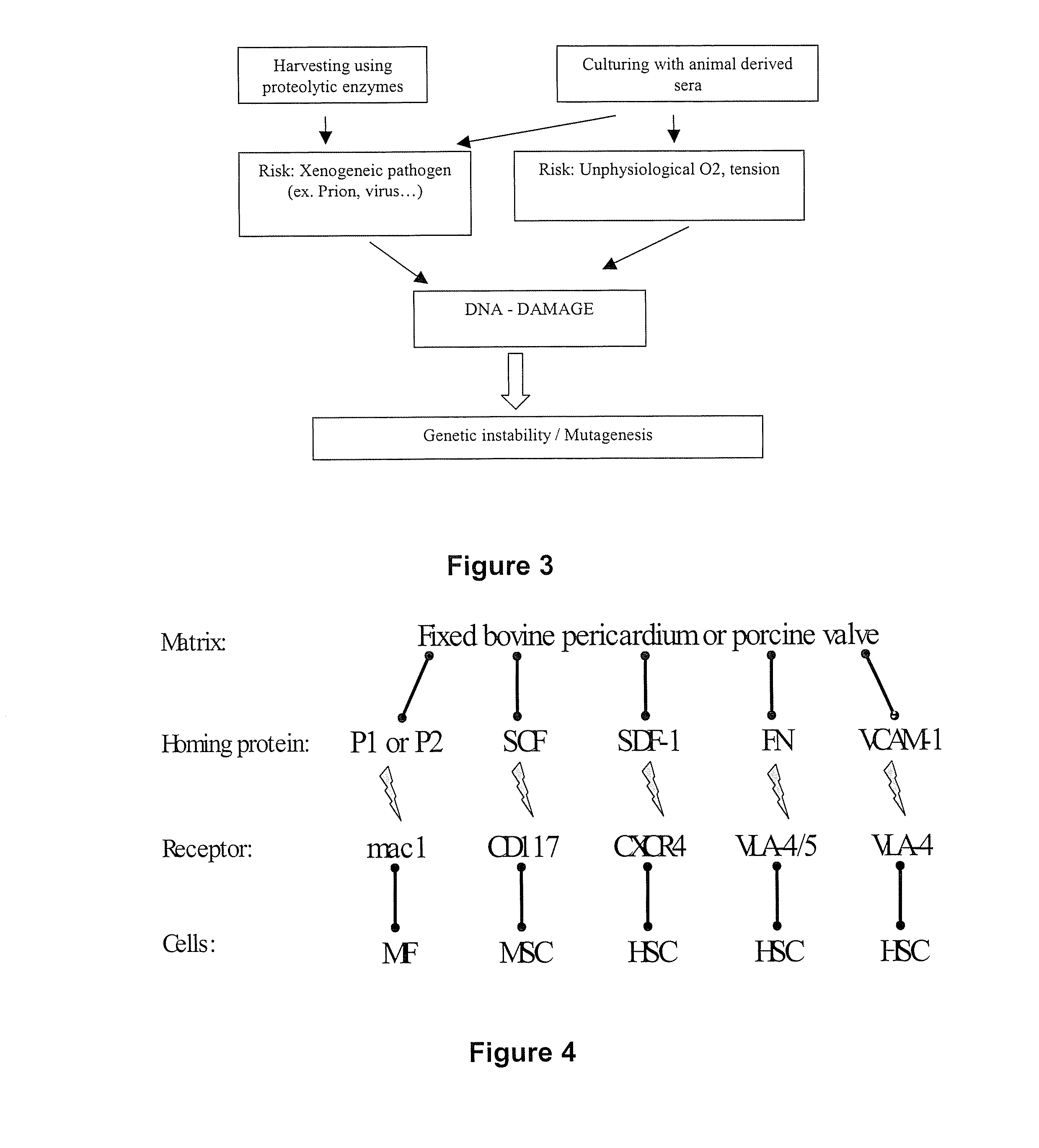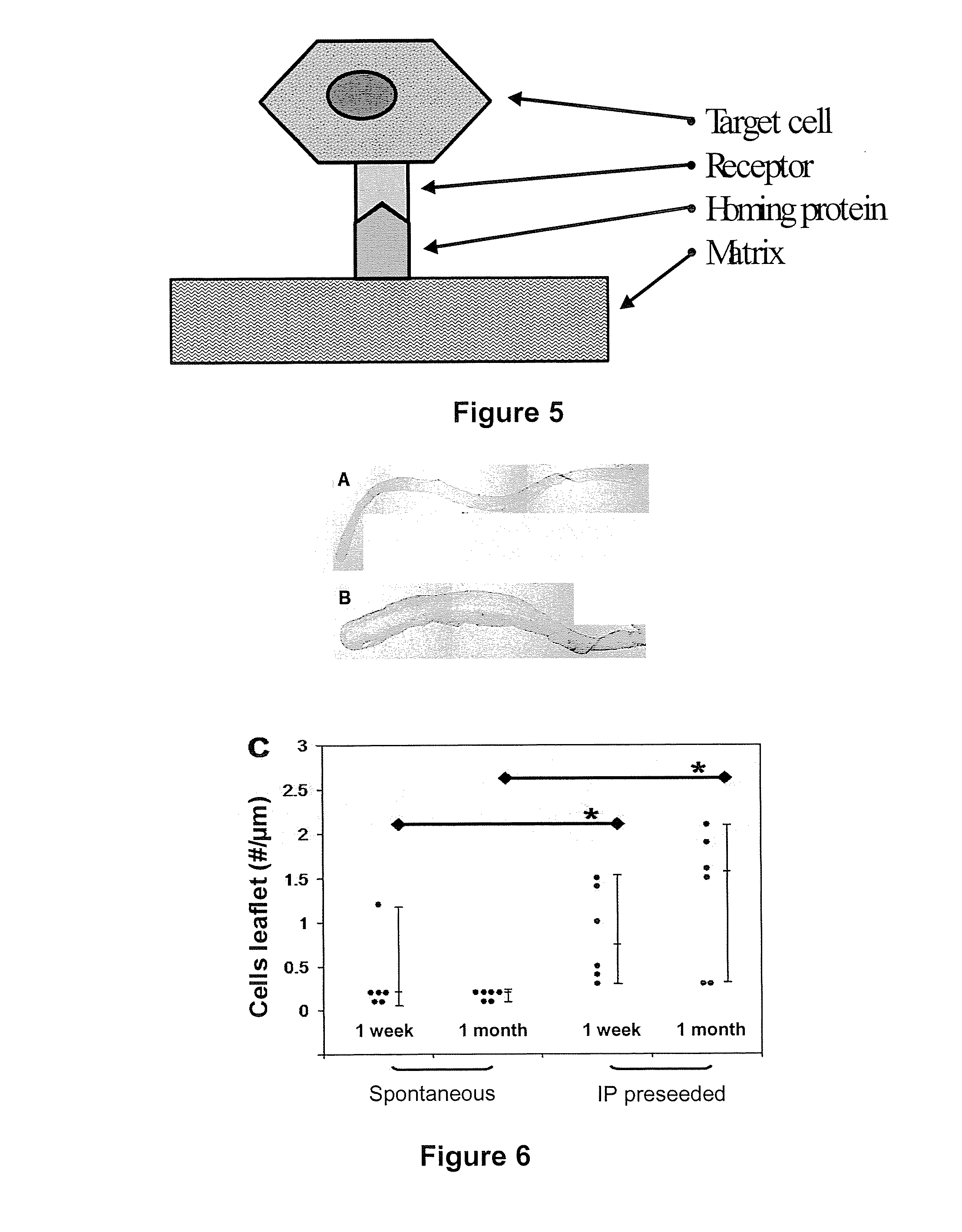Scaffold engineering
a scaffold and tissue technology, applied in the field of tissue engineering and to cell seeding of scaffolds, can solve the problems of specific problems affecting the use of in vitro cultured or even harvested cells, inducing genetic instability or mutagenesis of cells, and affecting the development of prosthetic heart valves
- Summary
- Abstract
- Description
- Claims
- Application Information
AI Technical Summary
Benefits of technology
Problems solved by technology
Method used
Image
Examples
example 1
Engineering a Valve by IP Implantation of a Scaffold
[0106] In order to obtain a seeded matrix for identifying the key factors involved in the adhesion of appropriate cells, an immature foreign body reaction was used to repopulate a cross-linked biological matrix, namely photo-oxidised bovine pericardium. Such a type of matrix ensures durability by itself. In sheep, a 3 day intraperitoneal (IP) implanted scaffold or patch becomes covered with blast-like cells with a mesenchymal origin and immature differentiation which could and do normally differentiate into a myofibroblast phenotype. More particularly, it was found that these cells were positive for vimentin but negative for α-smooth muscle actin and heavy chain myosin (see Table 1).
TABLE 1comparison between 3 day IP seeding in sheep and rats.CD44CD45CD172aVimentinASMASMMS-1PPH3CD34CD117Sheep0.0 [0.0, 0.0] 7.6 [2.2, 16.552.0 [19.9, 82.8]13.2 [7.5,0.8 [0.0,0.0 [0.0, 0.0]1.3 [0.2, 5.4]1.5 [0.0, 7.2]0.3 [0.2, 2.5](n = 10)89.0]15.4]...
example 2
Stem Cell Attraction to Intraperitoneal Matrix
[0116] Matrix material was introduced intraperitoneally in rats and the type of cells attracted was investigated.
[0117] Animals
[0118] Male Wistar rats (n=36; 380-400 g) were selected. Access to food was given ad libitum. All animals were cared for in accordance with the ‘Guide for the Care and Use of Laboratory Animals’ (NIH publication 85-23, revised 1985). The study was approved by the local Ethics Committee.
[0119] Procedure
[0120] Anaesthesia was induced with 4% isoflurane in 100% oxygen 1 l / min for 5 minutes and maintained with 2% isoflurane in 100% oxygen 0.5 l / min during the surgical procedure taking approximately 20 min. After shaving and disinfecting, a pararectal incision of approximately 1.5 cm was made through the skin, abdominal muscles and peritoneum. The stainless steel cage containing the matrix material was inserted into the abdominal cavity and fixed to the abdominal wall with transabdominal sutures (Ticron 3-0). The...
example 3
Specific Gene Expression in Tissue Neogenesis
[0132] As mentioned before, the tissue neogenesis was studied as it occurs in the FBR in adult animal models, because it is able to produce laminar tissue with a cellular component similar to vascular structures such as heart valves (et al. 2001a cited above; Butler et al. 2001b cited above). Unfortunately the mature tissue is not an ideal solution since it would require the construction of a valve prosthesis in the operation room, a method prone to variation of the valve quality (Grabenwoger et al. (2000) J. Heart Valve Dis. 9, 104-109). Nevertheless the tissue neogenesis in se is an interesting feature because it contains all the components, that is, the cells (example 2), new extracellular matrix, signaling molecules and homing proteins, necessary to construct a new tissue. Homing proteins, molecules responsible for the physical linkage of the cells to the extracellular matrix, were identified.
[0133] Similar to example 2, photo-oxidi...
PUM
| Property | Measurement | Unit |
|---|---|---|
| Time | aaaaa | aaaaa |
| Time | aaaaa | aaaaa |
| Fraction | aaaaa | aaaaa |
Abstract
Description
Claims
Application Information
 Login to View More
Login to View More - R&D
- Intellectual Property
- Life Sciences
- Materials
- Tech Scout
- Unparalleled Data Quality
- Higher Quality Content
- 60% Fewer Hallucinations
Browse by: Latest US Patents, China's latest patents, Technical Efficacy Thesaurus, Application Domain, Technology Topic, Popular Technical Reports.
© 2025 PatSnap. All rights reserved.Legal|Privacy policy|Modern Slavery Act Transparency Statement|Sitemap|About US| Contact US: help@patsnap.com



